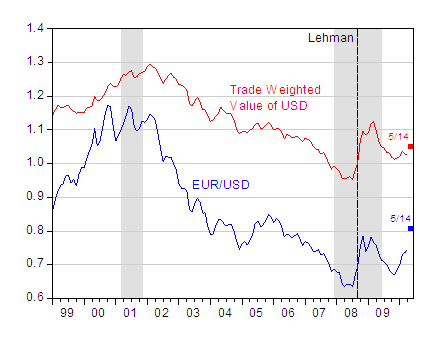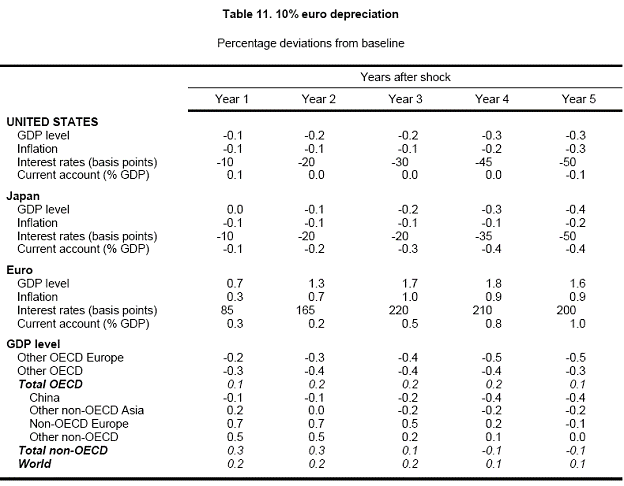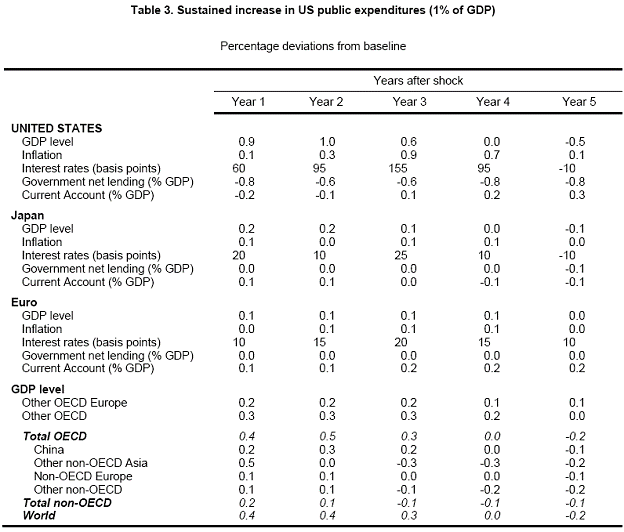The euro has been depreciating against the dollar over the past few weeks. The implications of this development for the US depend critically on (1) the extent of the depreciation, (2) the duration, and (3) the source of the depreciation. (See Jim’s post for other links.)

Figure 1: EUR/USD exchange rate, monthly averages (blue line), and value as of 5/14; and trade weighted value of USD against broad basket of currencies (red line), and value as of 5/14. NBER defined recessions shaded gray; assumes last recession ends 09M06. Source: Federal Reserve Board via FRED II, NBER.
The euro has depreciated since the 2009M11 average, by about 10.5% in log terms, and about 16.1% versus 2008M07, just before the Lehman bankruptcy. What the graph makes clear is that the first flight-to-safety induced dollar appreciation faded after about a year. This second dollar appreciation might be construed as another flight-to-safety. How lasting will this appreciation be? Much depends upon how and whether the euro area governments resolve the current crisis. It also depends upon the desirability of US dollar denominated assets, including Federal government debt.
Since I am less pessimistic than some others regarding the short to medium term deficit outlook for the US [0], I think that the upward appreciation of the dollar against the euro might be fairly persistent. That being said, Figure 1 also highlights the fact that euro movements do not translate one-for-one into dollar value movements. At the monthly to annual frequency, the elasticity is about 0.4 to 0.45 (calculated as log-changes on log-changes).
It’s difficult to evaluate the impact of exchange rate depreciation on GDP, and other variables, without taking a stand on what causes the exchange rate movements. The OECD has recently released documentation on their new macroeconometric model. One of the experiments implemented involves a 10% euro depreciation against a basket of currencies. From Karine Hervé, Nigel Pain, Pete Richardson, Franck Sédillot and Pierre-Olivier Beffy, The OECD’s New Global Model, Economics Department Working Papers No. 768 (May 2010) (h/t Torsten Slok):

The simulations are conducted in the following fashion:
The exchange rate simulations assume sustained 10% nominal effective depreciations,
individually for US dollar, yen and euro rates, against all other currencies, assuming that monetary policy
follows a standard Taylor rule and that fiscal policy is set by endogenous rule. Following depreciation in
the first quarter, the exchange rate is assumed to remain at the new level throughout the simulation period
with the sustained shift assumed to be exogenous, coming from unexplained movements in markets
expectations, rather than being policy induced or reflecting an identifiable change in economic
fundamentals. The possible endogenous influence of simulated changes in interest rates on exchange rates,
which might tend to offset the original shock, is therefore not taken into account. For this reason, these
shocks are not particularly realistic, but serve rather to illustrate the role and transmission channels of
exchange rates in the model.
The key channel is expenditure switching; a depreciation induces more spending on euro area goods, and less on those of the RoW. However, the table indicates the effect of a 10% euro depreciation would only have a modest impact on US GDP — a 0.2 percentage point deviation relative to baseline two years out, if sustained. The historical correlation between the euro/dollar rate and the BIS trade weighted value of the euro is about 0.5 (that is, the elasticity is about 0.5), so the euro depreciation since the April average is only about 5%, and hence the negative impact about half that indicated in the table.
There are other channels incorporated in the model, including valuation effects from exchange rate changes (see this post for discussion).
Part of the reason that the effect on the US is modest is that changes in the euro/dollar exchange rate are not the same as changes in the USD value. This is illustrated in Figure 1. The short run elasticity of (broad) trade weighted exchange rate with respect to the euro/dollar exchange rate is about 0.4-0.45 (at the one month to one year horizon).
The model is fairly conventional in terms of macroeconomics — in the short run output is largely demand determined, while in the long run it is supply determined (in other words, pretty much like in most standard macro textbooks). The key distinction is econometric; the key macro relationships are estimated using error correction models.
One channel that is not included (and would not be included in a open economy RBC [1] or a standard DSGE) is the effect coming from cross-border propagation of equity price declines. For that, one might need to appeal to financial stress indicators, as discussed in this post.
Interesting side point: the government spending multipliers are substantially greater than unity. The government spending multiplier in this model is slightly less than unity at the two year horizon, and much less as the economy adjusts to long run.

The multiplier, defined as the five 2 year cumulative deviation from baseline for a sustained one percentage point of GDP increase in government spending is 1.9; this multiplier assumes a Taylor rule for monetary policy. Presumably, with interest rates set at zero, the multiplier would be bigger.
Update, May 21, 11:11am Pacific:
See also Tim Duy’s views here and here. Note the previous version of the OECD macromodel was described in this post, and is described here.
How comes that the grey area of recession ends after the 2nd quarter of 2009 in your plot – AFAIK NBER hasen’t published the end of the recession yet, has it?
The first picture should read USD/EUR instead of EUR/USD.
What Does a Euro Depreciation Mean for the US?
Competitive devaluation! Got ammo?
Professor Chin:
As always, excellent info. Really appreciate your work.
Some questions on the fiscal multiplier:
1. When we hear about the fiscal multiplier being less than 1, does that mean that the long run (say, five years) impact is less than 1, or the peak impact (say in year 2) is less than 1?
2. Does the size of the fiscal multiplier depend on the year 0 level of public debt (say public debt outstanding as a % of GDP)?
3. Does the size of the fiscal multiplier depend on the year 0 level of trade balance?
I May have the tropism of a mechanic confronted to abscond theories, but could consideration be given to these stuffs?
U.S. Private Direct Investment Abroad (the curve require to be updated till may 2010)
http://research.stlouisfed.org/fred2/series/BOPOPDA
How much further” work” has the Vatican to do before it has completed its correlative forex rebalancing ?
External position of banks in foreign currencies vis a vis all sectors
in foreign currencies (billions usd}
France 768
Germany 882
UK 4961.4
External position of banks in FC viv a vis the non bank sector (in billions usd)
In individual reporting countries
France 281.3
Germany 410.6
UK 2149.3
Owe Jesse: Good point – I forgot the caveat; now fixed.
Martin: That’s my own (mathematically consistent) notation: Number of euros per US dollar. I figured it’d be obvious from the numerical values.
MarkOhio: It depends how the numbers are reported. Here I’m reporting the cumulative effect on output divided by the change in government spending. In regards to whether the value of the multiplier should depend on initial debt, yes. In regards to the trade balance, perhaps, although I don’t see how offhand. The multiplier should depend on the marginal propensity to import, however.
Thanks to Sean R.
When he spoke at The Heritage Foundation last month, supply-side founding father and Nobel Laureate Robert Mundell explained that since its inception, the euro’s value against the dollar has been highly unstable. It started at $1.18 in 1999, dropped to $.82 in 2001 before rising to $1.64 in 2008. Today it is around $1.22.
As a result of this instability — most of which can be blamed on the dollar’s excessive strength until 2003, then it’s sharp drop until 2008 — Europe’s economy has been battered.
Sixteen months ago, Mundell noted that because of the euro’s recent strength against the dollar, Europe’s near-term export position had been hampered, damaging its economy. Moreover, the euro’s strength would tip the currency zone into a deflationary position, raising the cost of debt and threatening bank solvency.
He suggested — again, more than a year ago — that the euro would fall, and hoped it would settle around $1.20, which he felt would fix most of Europe’s major economic problems.
Bear all this in mind when reading commentary that says the euro’s plunge is a sign of crisis and that the European Common Market experiment is a failure.
Sean R. is Sean Rushton.
Judging from the current popularity of gold in Europe, I suspect the Vatican may begin offering gold accounts again, at least to those citizens of Europe that spend leisure time in Monte Carlo. The marketing brochures will have pictures of the catacombs under Vatican City full of gold bars under the protection of the as yet untainted Swiss Guard.
But other than that, a $1.20 euro does seem about right on a purchasing power parity basis. The thing to convince people of is that it stops falling at that level.
The “fix” longer term is to boot the weaker economies out of the currency union and let them use their own funny money again. Economists say this makes everything better.
Except looking at the chart above, a 10% currency de-val raises borrowing cost by 2%. This was a major reason the peripheral euro countries originally wanted in the eurozone so bad.
Not much choice tho at this point unless Germany wants to essentially pay welfare to all these countries. They don’t and they can’t.
But economists can placate the peripheral euro countries by telling them how much better they will enjoy inflation than deflation. 20,000 Lira for a pair of shoes anyone?
BTW, any new government debt will be issued denominated in Euros or Dollars. We already have heard from economists how this is bad. The cool way is to issue new debt in Drachmas so you can de-val it. We will have to see if lots of economists invest. If not, I’m afraid debt will still be in euros or dollars or yen or RMB.
Also, my bet is they will need “hard currency” to pay for imports.
“Except looking at the chart above, a 10% currency de-val raises borrowing cost by 2%. This was a major reason the peripheral euro countries originally wanted in the eurozone so bad”
Uh, but in real borrowing costs, they will fall. The EU needs to go and be gotten rid of completely.
“What the graph makes clear is that the first flight-to-safety induced dollar appreciation faded after about a year. This second dollar appreciation might be construed as another flight-to-safety. How lasting will this appreciation be?”
My reading is a bit different. The dollar drop against the euro was overdone, helped by BB’s faster action (than Triche) in cutting interest rates in response to the recent downturn. Thus, when the ECB reduced interest rates, the U.S. carry trade declined and the dollar rose (though its rise was hindered by BB’s swaps, and is robably now being again retarded by these swaps).
I think Mundell (via RicardZ) has it about right. I would add the euro’s rise helped divert some of China’s export growth to Europe.
Yep – the value of the dollar bounces around also. And it has a strong impact on the size of the U.S. trade deficit in the short term (if the short term is a decade). Over several decades, the U.S. trade deficit responds to the “fundamentals”, which, today, include strong governmental actions in China and Germany to maintain a trade surplus with the U.S.
However, the broad, real,trade-weighted value of the U.S. dollar is now about where it was at the end of the decade of the Seventies.
Can’t rely on changes in currency value to create balanced trade in the world.
Hi,
Thank you for sharing this.
What are the options for forcing German to adjust its trade imbalance without hurting Europe?
German was a huge trade surplus country prior to the crisis. I agreed with many who have argued that German was a significant contributor to the imbalance within Europe. German used its trade surplus to finance the excess spending in Greece, Spain, etc.
Unlike German, China’s trade balance is rapidly correcting. China is pushing hard to increase domestic consumption.
retail sales:
http://econgrapher.blogspot.com/2010/05/china-economic-outlook-monthly-data.html?utm_source=feedburner&utm_medium=feed&utm_campaign=Feed%3A+EconGrapher+%28Econ+Grapher%29&utm_content=Google+Reader
trade balance:
http://econgrapher.blogspot.com/2010/05/china-international-trade-review-april.html?utm_source=feedburner&utm_medium=feed&utm_campaign=Feed%3A+EconGrapher+%28Econ+Grapher%29&utm_content=Google+Reader
German on the other hand is not taking steps to correct it’s huge trade imbalance. Angela Merkel has publicly stated that German will not “surrender its strength”. The latest data shows German’s trade surplus is still huge.
The current devaluation of the euro is benefiting German. It allows German to increase it’s trade imbalance with the rest of the world. German is hiding behind the euro and the media has not been particularly critical of it. Forcing the euro to appreciate would dampen the growth of Europe. What can be done to force a change within German without hurting the rest of Europe?
On a separate note, the following is my take away from the study on the falling eur/usd exchange rate.
– The negative impact of a devaluation of the euro on the US GDP is a small 0.1% (noise error).
– The positive impact on Europe GDP is a huge 0.7% for a region that typically grows around 2%.
– Now is an excellent time to invest in Europe! I am also long term bullish on the US.
I have seen a number of commentators (including some that I hold in esteem) decry German policies that artificially encourage exports, but I have not seen a convincing list of such measures that would appear to be effective and that should be discouraged (such as China’s currency interventions). Does anyone have such a list? If the surpluses are the result of market forces, I would have a hard time finding excuse to chastize Germany for its trade supluses.
Don,
It’s nothing that Napoleon II couldn’t fix.
I saw some data that showed German consumer debt is high (probably mostly mortgage debt), and if the consumer has a big mortgage, high income taxes, high gasoline taxes and a VAT then they will be unlikely to “increase consumption” the way economists say they should, even tho everything else sounds perfect.
The government is doing their duty with deficit spending, and they have a lot of “automatic stabilizers” that kick in, which would make economists giddy with excitement.
That leaves decreasing production capacity.
I’m not sure either if they have a lot of other kinds of export subsidies. I suspect not, but don’t really know. But the idea of the EU is to provide low import duties to their 400 million some members, and higher duties to outsiders. So maybe Germany sells a lot of Herr Coffees within the EU.
I think people are worrying too much. The momentum behind the global recovery is very strong. Almost every corner of the globe is having positive GDP growth. This includes Europe. Looking at the magnitude of the growth data of the world, a double dip in the global economy is very unlikely.
The action of the ECB and EU have ensured there will be no Greek default in 3 years. There is really not much the market can do to push Greece into default since Greece no longer need to finance its debt in the open bond market. Greece will not choose to default in less than 3 years simply because it doesn’t make economic sense for Greece to do so. Greece may default after 3 years, however the world will be a lot healthier by than.
The current European sovereign debt crisis may slow Europe’s recovery slightly. However, the impact on the world and the US is minimal (magnitude is within the range of noise). Econbrowser already covered this:
https://econbrowser.com/archives/2010/05/what_does_a_eur.html
In fact, the weak euro will help Europe a lot and not really hurt the world much.
I suspect the likely outcome is as follow:
The recovery of the nations within Europe will diverge. The strong countries such as Germany will recover faster. While weak countries such as Greece, Spain, Portugal, Ireland, Italy, and etc will recover slowly. The average overall recovery in Europe compare to other major economies will be slower. As such, the ECB will maintain a loose monetary policy for an extended period. This will lead to higher inflation (but not high inflation) in strong economies (let’s say 3% inflation for Germany). This will also keep the weak countries at near zero inflation and prevent any significant deflation (let’s say 0% inflation for Spain). This difference in inflation between the strong and the weak is the gradual mechanism that will allow Spain to incrementally gain a competitive advantage relative to Germany.